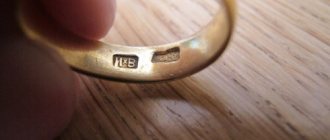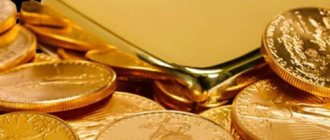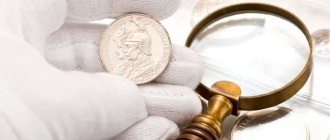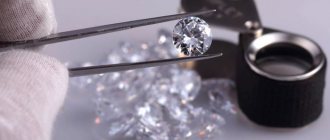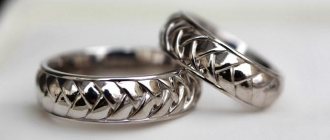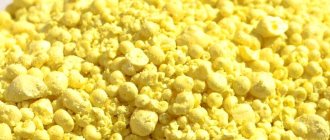Hi all! Today's topic is how to distinguish silver from fake. It is a popular noble metal that is widely used in various industries. Including the production of costume jewelry, as well as jewelry.
It is distinguished by its silvery-white color and high elasticity.
When buying silver products, many are interested in whether it is some kind of counterfeit.
Yes, fake silver is cheaper than fake gold. But still, no one wants to spend money on counterfeit goods.
Features of silver products
When choosing silver products, you must definitely consider it. The product must have two marks: from the manufacturer and according to the GOST standard. A sample is also required. Silver samples: 800, 830, 875, 925, 960, 999.
If there is no stamp on a product you like, this is not a reason to panic; most likely the standard is too low (below 800 - a stamp is not placed on the product) or the original jewelry was not made for sale.
Each product must have a manufacturer's tag, which indicates the name and legal address of the manufacturer, size, sample and name of the precious metal, as well as the cost of the product, weight in grams and price per 1 gram. The tag should be made of thick paper, wrapped in film.
Differences of silver:
- in its pure form it wrinkles easily;
- the surface is smooth and shiny;
- characteristic grayish color;
- the metal is highly susceptible to corrosion.
Physical impact
You can check the authenticity of silver using physical impact.
Rub the product to be tested in your hands for 1-2 minutes. If you have high-quality silver in front of you, then your hands will remain clean after rubbing; if the product contains zinc impurities, barely noticeable dark spots will remain on your fingers.
Try testing your silver with a needle. If you suspect that you have a silver-plated product, lightly scratch an inconspicuous (internal) area with a needle: a thin layer of silver will easily be removed from a fake, but nothing will happen to the genuine metal.
The expert will give accurate information about the authenticity of silver and determine the content of impurities of other metals
All the methods described above will help determine the authenticity of a silver product with a certain degree of probability. To get a 100% guarantee, have your item examined by professionals: they know exactly how to test silver.
It’s not difficult to distinguish silver from fake!
Recently, cases of counterfeiting of real silver have become more frequent. Under its guise they sell products made of aluminum, zinc and even tin. Such a fake is easily recognized by a professional, but not by the average person. In addition, many online stores on the Internet mark their silver as “silver.” or "silver pl.", which indicates silver plated rather than sterling silver.
Unlike gold, whose yellow color is difficult to counterfeit and replace with another metal, silver is identical in color to many other metals. Therefore, you definitely need to know how, when examining a product, to distinguish an item that is really made of silver, so as not to fall into the trap of scammers and not buy a fake.
How to distinguish silver from cupronickel?
Cupronickel is very similar to silver. Sometimes it is difficult to distinguish between products made of cupronickel and silver. Cupronickel alloy (copper and nickel with additions of iron and manganese) is a well-known simulator of precious metal. Some merchants specifically pass off such items as silver for profit. Cupronickel, compared to silver, has greater strength and resistance to oxidation.
Cupronickel products are often coated with silver. Cupronickel silver-plated cutlery and crockery look like real silverware.
Methods by which you can recognize a product made of cupronickel:
- on the product, instead of the hallmark characteristic of any precious metal, there is the abbreviation MNC,
- in water, a nickel silver product will almost immediately become covered with a greenish coating,
- when interacting with silver nitrate (you can use a lapis pencil, which is sold in a pharmacy), a dark spot forms on cupronickel,
- cupronickel products are lighter than silver ones,
- Cupronickel has a characteristic copper smell.
How to distinguish zinc from silver?
Iodine will help distinguish zinc from silver. For a simple procedure, you just need to drop it on the product. The silver will darken slightly and the surface of the zinc will turn blue. Zinc products (rings, for example) leave dark marks on the skin after wear.
Technical alcohol will also come to the rescue. You need to moisten a napkin in it and wipe the product. Zinc will leave dark streaks, just as it does when it comes into contact with the skin.
How to distinguish silver from aluminum?
It’s rare, but even aluminum is passed off as silver. Although this light metal has a different color and shine. After just a few days of wear, the aluminum jewelry will begin to deteriorate; this can be seen with the naked eye.
A magnet will help you distinguish a silver product from an aluminum counterfeit: aluminum will immediately be attracted to it, but silver will not. It’s easier than ever to identify aluminum by weighing: it is much lighter than silver.
And one last thing. Aluminum products are matte in appearance and do not shine like silver, since the metal is quickly covered with an oxide film.
How to distinguish silver from tin?
Tin is very similar in color and characteristics to silver, so it will be very difficult to identify a fake tin by eye. The analysis can be done at home using, again, iodine. Tin immediately turns black when it comes into contact with iodine.
How to distinguish silver from iron?
Iron from silver, as in the story with aluminum, will help to distinguish a magnet, to which the iron product will immediately be attracted. Iodine will also come to the rescue, one drop of which, as in the procedure with tin, is enough to form a dark, almost black spot on the surface of a product made of iron alloys.
How to distinguish white gold from silver?
In appearance, silver (high standard) and white gold are practically no different from each other. But professionals and simply knowledgeable people will easily find differences, both in color and in other characteristics.
White gold, although it is called “white”, has a barely noticeable yellowish tint, which will undoubtedly catch your eye when examining the product. In addition, the shine of a silver product is duller than that of gold.
When buying white gold, you should pay attention to the following details so as not to be deceived and buy fake silver instead of an expensive product :
- White gold jewelry looks like it has been varnished, while silver has a more matte appearance.
- Try. White gold is 585 or 750, and silver is most often 925.
- White gold is harder than silver. If you drag silver jewelry across paper, a mark will remain. White gold leaves no traces.
- Gold is not afraid of gentle acids. If you dip items made of silver and white gold, for example, in vinegar, then after some time the oxidizing silver will darken, but the gold will remain unchanged.
- Ringing sound from hitting a surface. White gold is a denser metal, so if you throw it from a height onto any hard surface, it will make a stronger ringing sound than a silver item.
Often, dishonest jewelers coat a silver item with a special radium solution, due to which the surface of the silver shines more and looks almost 100% like white gold. In this case, only weighing will help, because silver is much lighter than white gold.
How to distinguish platinum from silver?
When choosing platinum jewelry, you need to remember that this precious metal is very expensive, so massive jewelry made from it should cost a lot of money. If a seller offers an impressive ring or bulky earrings at an affordable price, then this is most likely silver that the scammer passed off as platinum.
Visually distinguishing silver from platinum is also not difficult. The color of silver is shiny gray, while like platinum it is several shades lighter, closer to white. Also, platinum is a harder metal; when it comes into contact with other objects, scratches do not appear on the surface, but silver immediately deteriorates from mechanical stress.
Magnet
Silver, like gold, is diamagnetic, so you can quickly check its authenticity using a magnet.
Bring a magnet to the item - if it is magnetic, it means that it is either a silver-plated item or made of another metal. If the item is not magnetic, there is a very high chance that it is real silver.
Testing with a magnet may not give the desired result if the main alloy material is copper. So, cupronickel and brass (copper alloys) will not be attracted to a magnet
Determine the purity of silver
Pure silver of the highest standard (999) is not used for jewelry and cutlery. This is because it is too soft, plastic and wrinkles easily. This kind of silver is called technical silver. Used in industry, for silver plating, as well as for casting silver ingots.
How can we determine that this is pure silver? Chalk and boiling water will help identify the 999 sample.
You need to rub the silver hard with chalk; if black stripes appear on the chalk, the silver is pure technical silver.
Due to its good thermal and electrical conductivity, silver will instantly heat up in hot water, just put it in a glass of boiling water.
You can also rub the silver with sandpaper: under the erased top layer it will be immediately visible whether there is silver inside or another metal.
Voice test
This test is suitable for checking coins. When tapped, silver makes a ringing sound (especially if it is tapped with another metal). If you already have a proven silver coin, its ringing can be taken as a standard.
Gently tap the silver item (you can use another coin for this): if when you tap you hear a beautiful, open ringing, then this is real silver. If the sound is dull, it means there is little or no silver in the alloy.
A silver service can become a family heirloom and be inherited from generation to generation
How to determine the authenticity of a silver item at home?
Needle
Pass it over the silver item with pressure. If a different color appears in the scratch, under the outer layer, this is most likely silvering of another metal. Silver-plated brass is often found, which can be easily seen, it has a red color.
Iodine
One drop of iodine (as mentioned above) is enough to make sure that the silver item is original and not a fake. The higher the silver standard, the darker the speck will appear after contact with iodine. And after reacting with iodine, a white limescale deposit will appear on the surface of other metals after it has been cleansed.
Magnet
Silver is not magnetic! If it does become magnetized, it is a silver-plated fake.
Vinegar
Having scratched the silver item a little, you need to drop vinegar into the scratch. An instant reaction with the formation of foam will show: the product is made of silver or it is a fake. Other metals produce a green foam when reacting with vinegar, and silver produces a white foam.
It is not difficult to distinguish real silver from a fake at home, but it is easier to buy silver products only in special jewelry stores with a guarantee, and not in dubious shops. Self-respecting jewelers have all their jewelry with a quality mark and approved.
Vinegar
You can test silver with vinegar.
Pour the 9% table bite solution into a bowl and lower the product into the container for a few seconds. Since silver is a low-reactive metal, it will not react with vinegar. If a white coating appears on the product or other changes occur, this is a fake.
You can use a bite to clean silverware and dishes until they shine.
Little trick
There is no need to set up a mini-laboratory at home to determine the authenticity of the products. Just go to the pawnshop and hand over the item for appraisal. And then take it and leave, as if you weren’t satisfied with the price, it’s really small there! This is the simple method we propose in conclusion.
To be sure of the quality of any purchase, do not purchase jewelry from your own hands. After all, these are not acquisitions that are made spontaneously! And most often there is no urgent need for them.
How do you like the article?
Thermal method
One of the properties of silver is thermal conductivity, due to which the metal quickly heats up to ambient temperature. If you hold the product in your hand, it will almost immediately heat up to body temperature. When immersed in cold or hot water, the metal will quickly return to the same temperature.
Boiling water is a good way to test the quality of a silver alloy. When removed from a hot product, it burns the skin and quickly cools to room temperature. Fake silver removed from boiling water will be lukewarm.
How to calculate a sample at home
Of course, the simplest solution is to contact a specialist. But if you do not have such an opportunity or have a desire to carry out this procedure yourself at home, then you will have to resort to the use of chemical reagents and knowledge of physics.
Potassium dichromate
The reagent with such a complex name is called Chrompik. Before using it, you need to prepare the product itself. Degrease, clean and dry the decoration. It is necessary to apply several drops of the reagent sequentially, at intervals of 2-3 seconds, to the surface, wiping them with filter paper. If a brown spot appears, then you are dealing with a sample from 500 to 750. If a red spot appears, then the sample is higher than 750. The deeper the red color, the higher the standard.
Chlorine nitrogen
This method is not as accurate as the previous one, but overall no less effective. The surface of the product being tested should also be cleaned, degreased and dried. After applying the reagent, the reaction should be immediate. Only in this case it is not the object that reacts, but the reagent itself. And you need to look at the color of the drop. If it gives out a very dark shade, then most likely we are talking about a high standard. The lighter the drop, the lower the sample. If the shade is yellow or brown, then you are dealing with aluminum or copper.
Sulfur ointment, nitric acid, whiteness
The principle of testing is the same as when testing with iodine. We apply a drop of the reagent to the product, wait and see if the product reacts to the drugs:
- A real silver item will show tarnish where the substances were applied.
- Nothing will happen on a fake.
Reaction to chemical exposure.
